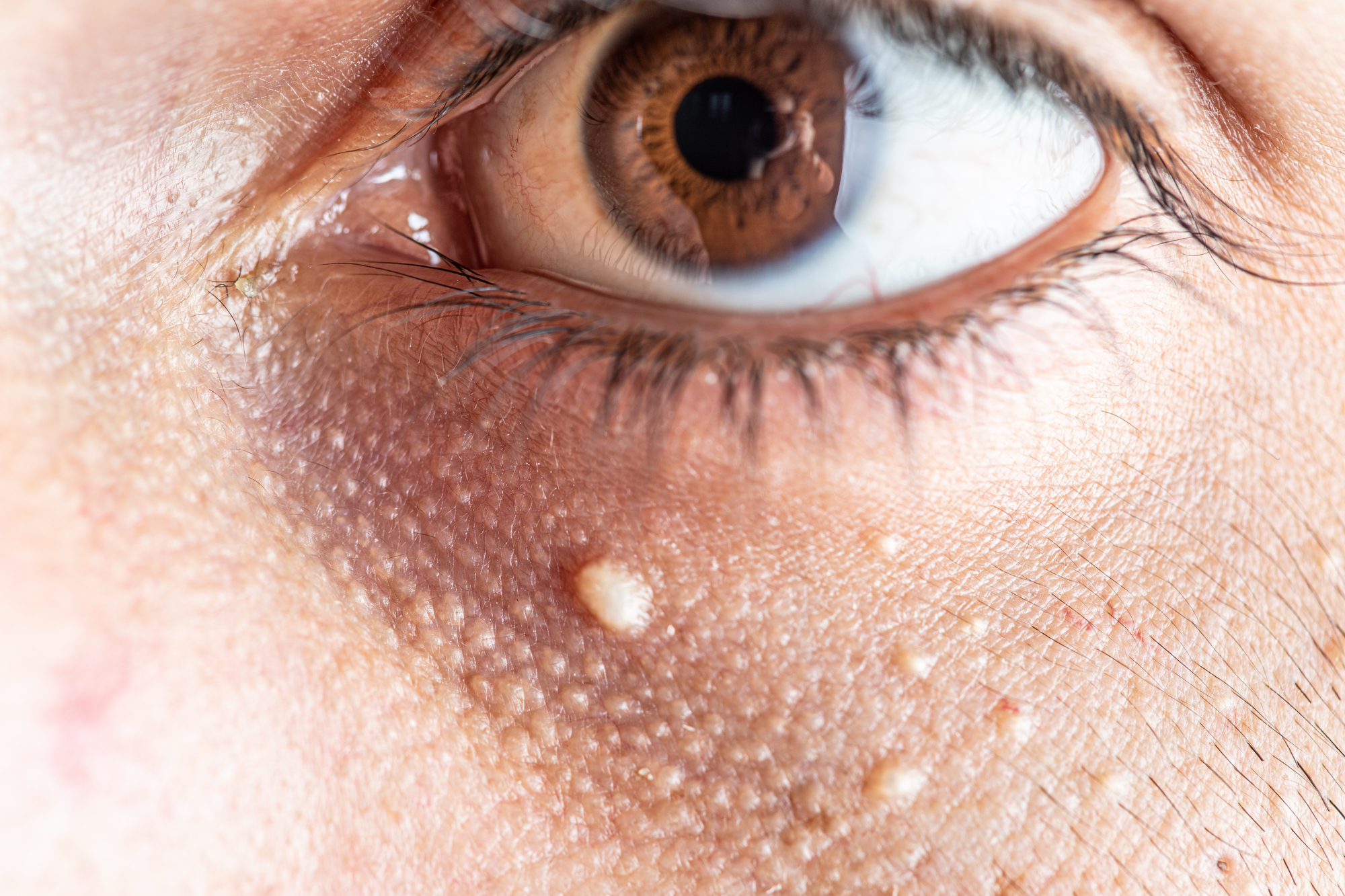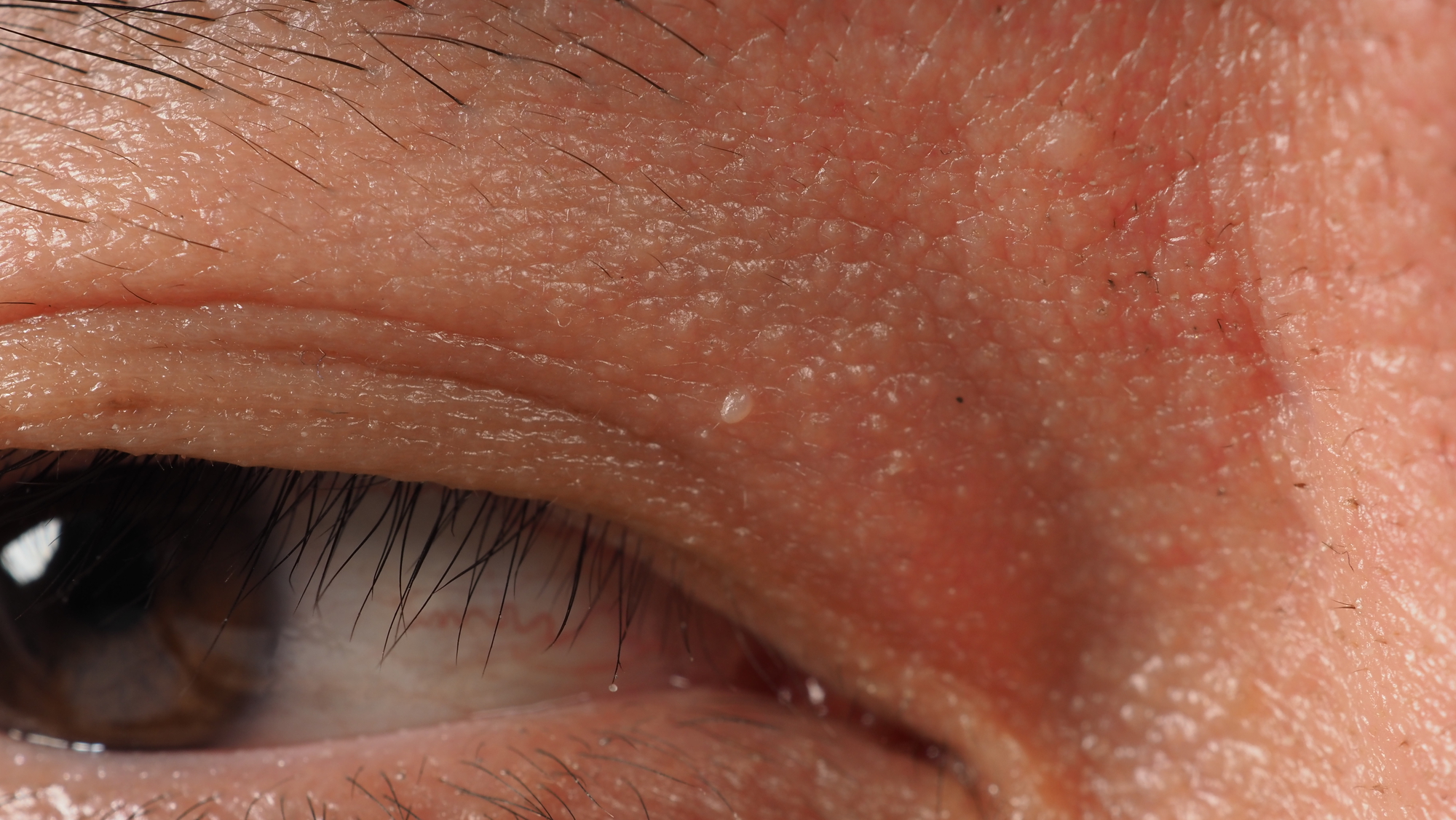Updated on October 21, 2024
Milia: Causes, Symptoms & How to Treat Them


Vision Center is funded by our readers. We may earn commissions if you purchase something via one of our links.
What is Milia & Where Does it Form?
Milia are tiny white bumps that develop on the skin’s surface.1 It occurs when keratin gets trapped underneath the skin. Keratin is a protein that makes up your hair, nails, and skin.


However, unlike whiteheads, milia aren’t symptoms of clogged pores. The bumps are usually found on:
- Faces
- Lips
- Eyelids
- Cheeks
They may also develop in other body areas, like the torso or genitalia. Milia aren’t usually itchy or painful, but they may cause discomfort. Rough clothing or sheets may cause it to appear irritated and red.
What Causes Milia & Who is at Risk?
Newborn babies often have milia. They are also common in older children.
Adults may also develop milia, especially on the cheeks or below the eyes. However, the causes of milia differ from those in newborns compared to older children and adults. Eye diseases are not usually the cause of milia.
Newborns
The cause of milia in newborns is unknown. Infants with milia are typically born with it.
They are often mistaken for baby acne, which occurs from hormones from the mother. Unlike baby acne, milia doesn’t lead to inflammation or swelling.
Milia on newborn skin also doesn’t need to be treated. They will typically go away on their own in a few weeks.
Older children and adults
Milia is typically connected to skin damage in older children and adults. Damage to the skin may include:
- Blistering due to a skin condition like epidermolysis bullosa, cicatricial pemphigoid, or porphyria cutanea tarda
- Blistering injuries like poison ivy burns
- Long-term sun damage
- Long-term use of steroid creams
- Skin resurfacing procedures like dermabrasion or laser resurfacing
Milia can also occur if the skin loses its natural ability to exfoliate as it ages.
Types of Milia
The two types of milia are primary and secondary. These are classified based on the age and the underlying cause.
Primary milia develop directly from trapped keratin. These cysts usually form on the faces of infants or adults.
Secondary milia (traumatic milia) look similar to primary milia. However, they develop after something blocks the ducts leading to the skin’s surface. This blockage can be caused by an injury, blister, or burn.
Neonatal Milia
Neonatal milia occurs in newborns and heals within a few weeks. The bumps are usually seen on the following:
- Face
- Scalp
- Upper torso
Juvenile Milia
A rare genetic disorder that affects the skin can result in juvenile milia. These conditions include:
- Nevoid basal cell carcinoma syndrome (NBCCS). A hereditary condition characterized by multiple basal cell skin cancers
- Pachyonychia congenita. This condition may lead to thick or abnormally shaped nails
- Gardner’s syndrome. This rare genetic disorder may progress to colon cancer over time
- Bazex-Dupré-Christol syndrome. This syndrome affects hair growth and the body’s ability to sweat
Milia en Plaque
This condition is linked to genetic or autoimmune skin conditions, like discoid lupus or lichen planus. Milia en plaque can affect:
- Eyelids
- Ears
- Jaw
- Cheeks
The bumps can be several centimeters in diameter. Milia en plaque is commonly seen in middle-aged women but can develop in adults or children of any age or sex.
Multiple Eruptive Milia
This is characterized by multiple milia formations on the skin. These are itchy and appear more than expected in primary milia.
Multiple eruptive milia can be found on:
- Faces
- Upper arms
- Torso
These cysts often occur over a period ranging from a few weeks to a few months.
Milia Linked with Drugs or Products
Drug-induced milia is caused by products such as steroid creams and hydroquinone creams. It’s considered your body’s reaction to the drug.
This form of milia is rare, with no significant signs and symptoms. If you stop or discontinue using creams, it may decrease the milia’s progression.
How to Get Rid of Milia
While milia aren’t a cause for concern, some people prefer to remove them. Here are a few ways to remove them:
Professional Treatment

A dermatologist may be able to treat milia under your eyes with one of the following procedures:
- Deroofing. During deroofing, a dermatologist uses a sterilized needle to remove the milia from under your eyes
- Cryotherapy. In cryotherapy, liquid nitrogen freezes the milia and destroys it; this procedure isn’t always recommended for areas close to your eyes
- Laser ablation. During laser ablation, a small laser focuses on the milia to open the tiny cysts to remove the keratin buildup underneath the skin
Home Remedies
There are also various home remedies to help clear up milia:
- Exfoliating. Gently exfoliating the area with a warm washcloth may remove some dead skin cells and help trapped keratin rise to the surface
- Steaming. Spending some time in the bathroom with the door closed and a hot shower running can provide an easy at-home steam treatment for your skin
- Rosewater and manuka honey. The anti-inflammatory properties in roses and honey can help clear up milia
Over-the-counter products
You can also buy over-the-counter products to heal milia under your eyes. These include:
- Topical alpha hydroxy acids. Products with glycolic and lactic acid can promote healthy skin; you can find these ingredients in products like face toners, masks, and skin peels
- Salicylic acid treatments. These may help release keratin trapped between skin layers, they’re present in exfoliating creams and cleansers
- Over-the-counter topical retinoids. These help old skin cells and trapped toxins rise to the skin’s surface; they also promote cell turnover and reduce stickiness
Before purchasing products to treat milia, read the label to ensure it is safe to use under the eyes. Since this area is very sensitive, you may need to choose products specifically designed and marketed for under the eyes.
Does Milia Require Treatment?
Milia doesn’t need to be treated. They usually clear up within a few weeks to months.
However, you should get rid of them sooner for cosmetic reasons.2 See a doctor or dermatologist to get rid of milia.
They can help diagnose milia if you are concerned about the appearance. A doctor or dermatologist can also help remove milia if they bother you cosmetically or are irritated.
Listen In Q&A Format
Milia Causes Symptoms How To Treat Them
Vision Center Podcast
How Long Does it Take for Milia to Go Away?
Milia in children usually clears up within a few weeks. In adults, milia typically take a few months to heal, depending on the underlying cause.
However, if your milia doesn’t improve within a few weeks, you may want to check in with your doctor. They can make sure it is not another skin condition.
How to Prevent Milia
If you keep experiencing milia under your eyes, consider adjusting your skincare routine. You should regularly clean, exfoliate, and moisturize your skin. However, too much exfoliation can irritate your skin.
If you are prone to milia, choose oil-free soaps and cleansers. You can also consider using a night serum containing vitamin E or topical vitamin A approved for under-eye use.
As you age, your body loses some ability to exfoliate dry skin. Serums can retain moisture and encourage cell growth while you sleep.
Vitamins that can Help Prevent Milia
Ensure you get enough vitamins and nutrients that make your skin healthy. If you are concerned that you are not getting enough vitamins from your diet, here are some oral supplements you can try:
- Vitamin E
- Vitamin B-3 (niacin)
- B-complex vitamins
The Food and Drug Administration doesn’t monitor or regulate supplements. You must speak with your doctor for medical advice before trying supplements. Some may interfere with the medications you are currently taking.
What Not to Do if You Have Milia
If you have milia, avoid picking or poking at the small cysts. Leaving milia alone helps them heal faster.
If you pick the bumps to the point they become irritated, the milia may lead to infection and scarring.
Summary
Milia are tiny white bumps that develop on the skin’s surface. They typically occur when keratin gets trapped underneath the skin.
There are two types of milia, primary and secondary. Other primary and secondary milia forms are also based on age and the underlying cause.
Milias don’t require treatment and often go away on their own. However, there are ways to remove them if you want to.
In this article
6 sources cited
Updated on October 21, 2024
Updated on October 21, 2024
About Our Contributors
Ellie is a full-time freelance writer with a diverse portfolio in the medical field, including a focus on optometry. She crafts content in areas such as dentistry, addiction, mental health, and eye care. Her mission is to produce authoritative and research-backed optometry content, guiding readers to take care of their eyesight and seek necessary treatments.
Dr. Melody Huang is an optometrist and freelance health writer with a passion for educating people about eye health. With her unique blend of clinical expertise and writing skills, Dr. Huang seeks to guide individuals towards healthier and happier lives. Her interests extend to Eastern medicine and integrative healthcare approaches. Outside of work, she enjoys exploring new skincare products, experimenting with food recipes, and spending time with her adopted cats.

